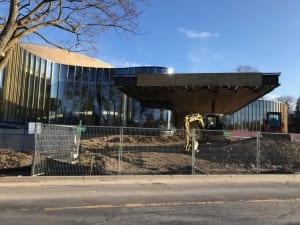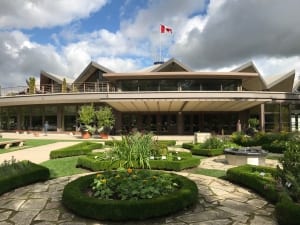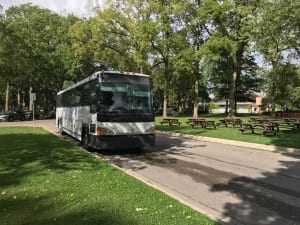Storytelling depends upon the pragmatics of communication inherent in a conversation: the ball gets hit back and forth across the net
A conversation is like a game of tennis. So long as the ball gets hit back and forth the conversation continues. I learned about pragmatics years ago when I helped to write a curriculum document for a school board that was in place across the Greater Toronto Area. The board was called the Metropolitan Toronto School Board (MTSB). From the name itself, it is clear that this board was in existence before the amalgamation of the City of Toronto. It folded not long after amalgamation.
In the mid-1990s, the Peel District School Board (PDSB) was looking to hire more teachers. A big hiring push was on because the Peel Region was growing rapidly thanks to immigration. The schools were packed with students. As a result I went to work for the PDSB and along with my students we all had a good time.
To get back to the MTSB (see above), I was involved years ago in producing a curriculum document for teachers explaining how to enhance language acquisition among profoundly disabled students who were not yet speaking. In reading an article or book-chapter about language acquisition, I learned about the concept of pragmatics.
Pragmatics deals with the fact that a conversation (as between a parent and a very young child) is like a game of tennis. In such a game there is a sharing of attention. Players are gazing at the same thing. People take turns. The ball is hit across the net and it gets hit back. The conversation proceeds so long as the ball keeps moving.
Erving Goffman has described how a given social interaction is kept aloft (kept going) thanks to various efforts on the part of participants in the interaction. He also speaks of situations where the interaction abruptly falls apart. There are times when the tennis game is over. Either the game begins anew or we move on to something else.
I had never learned a thing in university about pragmatics before I began to work as a teacher at the MTSB. But as an MTSB teacher, I latched onto the concept as soon as I read about it. In my subsequent decades of volunteer work in support of community self-organizing, the concept of pragmatics has come in handy.
A positive feature of large-scale volunteer work is that a person can readily choose their working conditions. A person can decide when to continue the tennis game and when to move on. In some cases you want to keep the conversation going because you want to complete a project. If a given venue if not congenial, however, a person can instead just choose another venue for the same kind of work. As long as you’re making a contribution, who cares where you work? The beauty of volunteer work is that you work to an extent outside the market system. Instead, your work takes primarily within civil society, which to an extent has a different way of seeing the world than does the market system.
These approaches – the market system and civil society – overlap; one cannot readily separate one from the other. However, each entails a somewhat distinct way of seeing. Each works with agency, power, and status in a slightly different way. Perhaps the one thing they have in common is that they both work with the channelling and mobilization of a attention at the level of the individual and the group. You’re dealing with the startup and maintenance of a wide range of (metaphorically speaking) games of tennis. These are among insights that occur to me many years later; I am no longer involved with intensive volunteer work as I was before. I have the opportunity to ponder and share what I have learned.
Pragmatics of sense making
In a previous post regarding the gentrification of the Lachine Canal, I have referred to the concept of Authoritarian High Modernism. The latter concept concerns a particular form of pragmatics. First, you have all manner of conversations in academic, planning, and policy circles. Then the conversations move into the realm of land use decision making. So long as the tennis game continues, you have specified results on the ground. High modernist planning gives rise to particular forms of land use which involves conversations of a particular kind. The results on the ground of such conversations directly affect people’s lives. The results may manifest themselves in the acceleration of differences in levels of income, forms of available housing, and life opportunities available to specified segments of society.
Looking at life from the level of a state bureaucrat differs from looking at life from the level of local knowledge and experiences. In each case there is a tennis game at play. If the play is strictly at the state level and the game at the local level is not permitted to proceed, the results have in many cases been disastrous as many observers have noted.
One can discuss this another way by speaking of high modernism. Previously I have noted that James C. Scott makes a point (p. 6 of Seeing Like a State (1998)) of underlining that his research builds a case against the imperialism of a high-modernist, planned social order. He stresses the word “imperialism” because he’s “not making a blanket case against either bureaucratic planning or high-modernist ideology.” Instead, what he opposes is “an imperialist or hegemonic mentality that excludes the necessary role of local knowledge and know-how.”
I have extended this discussion in a post entitled: In Seeing Like a State (1998), James C. Scott outlines a faith-based, uncritical, high-modernist ideology which gave rise to historic twentieth-century disasters.
It’s good to achieve clarity in the use of language. I’m reminded that we are in some cases dealing with the matter of what does or does not qualify as a scam. Scams and scamming are among topics that many site visitors have made a point of reading about over the years. Scams depend on a particular form of hijacking. They cannot proceed unless the tennis ball gets hit back and forth. Whether or not something is a scam depends on the outcome of a process of disambiguation. Tennis games come in many guises.
Pragmatics of environmentalism

Although the Stratford Festival season was postponed for a while on account of the COVID-19 pandemic, work proceeded steadily and was finally concluded at the Tom Patterson Theatre construction site. Jaan Pill photo
A related discussion concerned in particular with the concepts of ecology and environmentalism (which mean different things to different people) appears in The Nutmeg’s Curse: Parables for a Planet in Crisis (2021) by Amitav Ghosh.
When environmentalism is part of a conversation, it’s useful to consider who is involved in the conversation and also whether the conversation is at the level of “seeing like a state” or at the local level. It’s also useful to consider whose version of sense making is at play. Is it a non-Indigenous version, for example, or an Indigenous version? Some conversations about the environment make sense (which warrants keeping the tennis game going) and some make no sense at all (the game warrants cessation).
I have elsewhere cited Ronald Wright who has characterized Western civilization as a pyramid scheme. In other words, there are arguments which can be advanced to back up a claim that what is termed the Enlightenment can be characterized as an elaborate scam sustained by a multitude of learned conversations. Pyramid schemes give rise to impressive (even momentarily inspiring) gains in materiality for some until the plot unravels.
It appears there are trade-offs with regard to the Enlightenment. No point in oversimplifying. There are aspects that appear good enough. That said, the Enlightenment has been a key driver of the climate crisis. I have often gone for long walks in Stratford where I live. Not recently, however. A Special Air Quality statement is currently in effect regarding poor air quality due to smoke from forest fires; an excerpt from a recent such statement reads:
If you must spend time outdoors, a well-fitted respirator type mask (such as a NIOSH certified N95 or equivalent respirator) that does not allow air to pass through small openings between the mask and face, can help reduce your exposure to the fine particles in smoke. These fine particles generally pose the greatest risk to health. However, respirators do not reduce exposure to the gases in wildfire smoke. It is important to listen to your body and reduce or stop activities if you are experiencing symptoms.
A June 6, 2023 CBC article is entitled: “How to better protect yourself from the health effects of wildfire smoke: Experts suggest planning, even after the air clears.”
A Feb. 23, 2022 United Nations article on climate change is entitled: Spreading like wildfire: the rising threat of extraordinary landscape fires.”
An excerpt (I have omitted an embedded link) reads:
A new report, Spreading like Wildfire: The Rising Threat of Extraordinary Landscape Fires, by UNEP and GRID-Arendal, finds that climate change and land-use change are making wildfires worse and anticipates a global increase of extreme fires even in areas previously unaffected. Uncontrollable and extreme wildfires can be devastating to people, biodiversity and ecosystems. They also exacerbate climate change, contributing significant greenhouse gasses to the atmosphere.
An Aug. 12, 2022 New York Times article is entitled: “Wildfires Are Intensifying. Here’s How to Protect Your Health: Wildfire smoke is ‘like tobacco smoke without the nicotine,’ one expert said. Here are some ways to keep yourself — and your family — healthy.”
An excerpt reads:
Some of those particles, including dust, dirt, soot or smoke, are so large or dark that they can be seen with the naked eye. But the tiniest of them — microscopic particles that are about one-fifth to one-thirtieth as wide as a human hair — can travel deep into your lungs and even into your bloodstream. There, they can cause inflammation and dampen your immune system.
While ash and soot from burning wood are some of the most concerning types of particle pollution, wildfire smoke can also contain other toxic and cancer-causing substances, including chemicals, heavy metals and plastics. Indeed, said Dr. John Balmes, a pulmonologist and professor of medicine at the University of California, San Francisco: Smoke from fires is “pretty much like tobacco smoke without the nicotine.”
The Falling Sky (2013)
Of related interest is The Falling Sky: Words of a Yanomami Shaman (2013) by Davi Kopenawa and Bruce Albert. Studies in which Indigenous perspectives regarding pressing global issues are expressed in the words of Indigenous peoples themselves, in conversations of their own choosing, in contrast to being purportedly explained by non-Indigenous observers, are of value.
Also of interest: A Cree Healer and His Medicine Bundle: Revelations of Indigenous Wisdom (2015) by David E. Young, Robert Dale Rogers, and Russell Willier and Plant Teachers: Ayahuasca, Tobacco, and the Pursuit of Knowledge (2021) by Jeremy Narby with Rafael Chanchari Pizuri.
Shakespeare
I subscribe to the Substack newsletter of Phillips P. O’Brien. I learned of this newsletter on Twitter. I spend less time on Twitter now and instead read newsletters from Phillips P. O’Brien and a few other students of strategic studies that I learned about through Twitter. Warfare is about hitting the tennis ball back and forth until the war is over.
I have featured some photos connected to the Stratford Festival given that I live in Stratford and have written about the history of the Stratford Festival. Shakespeare and drama are all about the hitting back and forth of the tennis ball. It’s wonderful to see so many people from all around the world turning up once again to enjoy theatrical events in Stratford!



By way of an update about air pollution from forest fires, a June 7, 2023 New York Times article is entitled: “As Smoke Darkens the Sky, the Future Becomes Clear.”
An excerpt (I’ve omitted embedded links) reads:
Until now, if people in the green and leafy Northeast looked at arid Western cities covered in smoke from wildfires, they could say, that can’t happen here, thank God. On Tuesday, it did: For a moment, New York’s air quality was worse than it was in Delhi, the infamous pollution capital where average life spans are reduced more than nine years by particulates in the air. By evening, New York had registered the worst air quality in the world among major cities. And staying indoors may not provide perfect protection.
A second excerpt from the above-noted article (again, links are omitted) reads:
This is especially distressing because of all we are learning about the poisonous effects of particulate pollution on nearly all measures of health. Globally, all forms of air pollution are responsible for perhaps 10 million deaths each year, and, short of mortality, contribute to respiratory disease and cardiac disease, Alzheimer’s and Parkinson’s, dementia, cancer, mental illness and suicide, miscarriage and premature birth and low birth weight. According to some recent research, of all forms of particulate pollution, wildfire smoke may be the most toxic.
A third excerpt reads:
But the smoke pouring in from the north may mark another perspective shift, away from the American West as the fountainhead of wildfire. Ten percent of the world’s forests rise up from Canadian soil, John Vaillant writes in his mesmerizing new — and unfortunately, exquisitely timed — “Fire Weather: A True Story From a Hotter World.” Increasingly, those forests look poised to burn.
I buy my masks at Vitacore:
https://mailchi.mp/93365a243e6a/breathe-clean-during-wildfires-this-summer-6213676?e=cffd13ea08